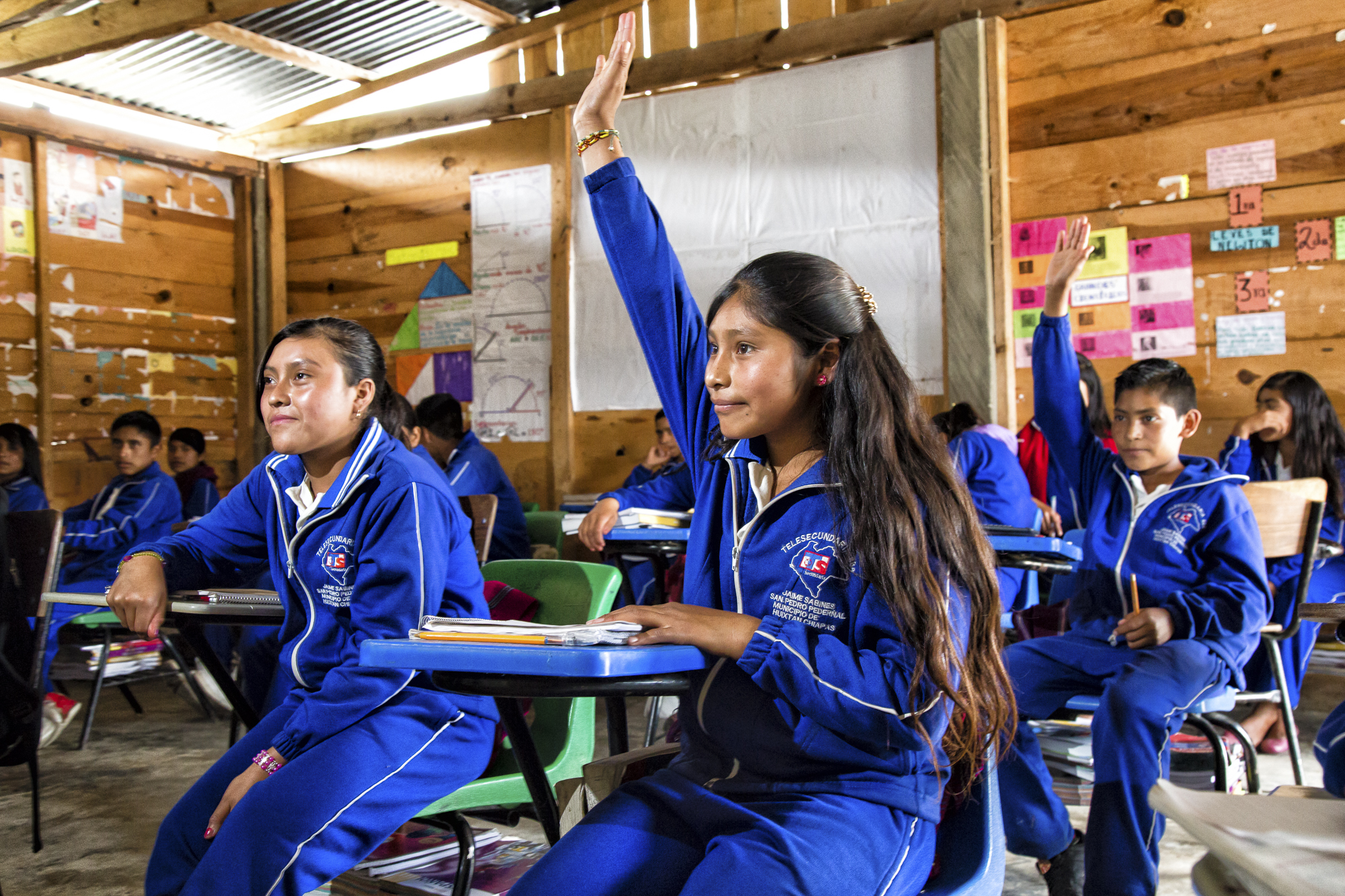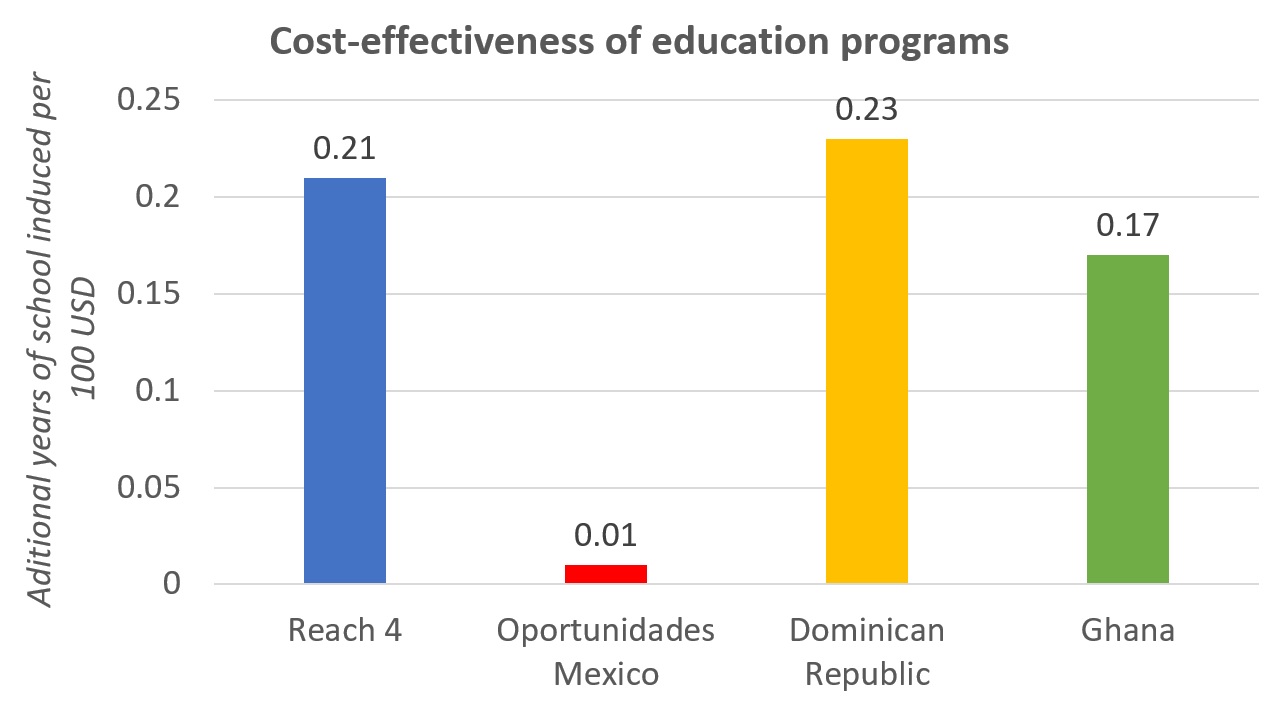Summary
Since 2013, the Escalera Foundation has generated evidence on the most efficient types of incentives to reduce school dropout rates in the most marginalized area of Mexico, the state of Chiapas. Through randomized controlled trials, the REACH program has assessed the effects of providing subsidies or subsidies and motivational materials to young people who are transitioning from junior high to high school. The latest results of this program indicate that, in general, subsidies have a positive effect on school continuity, even more so if these subsidies are accompanied with motivational content (showing an increase of six percentage points). Along with this evidence, Escalera identifies various relevant factors to ensure success in programs that combat school dropout rates in rural and indigenous contexts.
The world is going through a demographic trend in which the youth population is becoming key to influencing the development of new economies. Today, 1.8 billion people are between 10 and 24 years old, and nine out of 10 of these young people live in a developing country. The youth populations in these countries are particularly vulnerable and affected by school dropout, job insecurity, and unemployment. In Latin America, 21 percent of those between 15 and 24 do not attend school, training, nor work (NEET)2. The case in Mexico is no exception: only 60 percent of the 30 million youth attend high school, and 22 percent are NEETs3. Encouraging young people to continue studying is a challenge, every year 1.5 million Mexicans drop-out of high school with 80 percent of this population doing so due to the need to generate an income that contributes to the family economy4.
Faced with the imperative of contributing to the right to education of young people, the Escalera Foundation has worked for 20 years in the development of evidence-based programs that reverse the drop-out cycles in the most marginalized communities in Mexico. In the state of Chiapas, southeast of Mexico, 77 percent of the population lives in poverty5. Of the 1.5 million young people, 80 percent have grown up in poverty and half live in extreme poverty6. Furthermore, the educational level is the lowest in Mexico, with an average of seven years of schooling, that is, with most students not finishing middle school7.
What Is Needed So That Young People Continue Studying?
To understand the phenomenon of school dropout in Chiapas, the Escalera foundation aimed to identify the barriers that prevent young people from continuing their studies, as well as to design a social intervention that efficiently addresses this problem. At the early stage of the program, in 2013, “Reach” (short for High School within Reach) offered an innovative way to accompany 2,555 students in their transition process to high school. Through a “tutor in a box”/ “mentor in a box.” youngsters in their senior year of junior high school received a manual with information on the benefits of continuing to high school along with a list of the high schools available near their community. This information is not redundant in rural and indigenous contexts where young people work from a very young age in subsistence agriculture and adolescent women are still exposed to arranged marriages within their community. For this reason, a guide was offered that would help the decision making of young people, who are mostly the first generation of their families to attend the upper-middle levels of education. At the same time, Reach also offered financial incentives to support students for the first two years of high school. With this initial design, Escalera undertook a learning path on the informational and economic barriers that affect the educational continuity of the young, mostly indigenous, of Chiapas.
How Does the Reach Program Work?

Innovation of the programme – Source: Escalera
The Reach program has been growing in each of its phases; in its latest edition it reached more than 15,000 students from Chiapas. To date, 58,000 young people in their last year of junior high have benefited from the REACH program. This scaling-up has been possible thanks to the financing of public organizations such as USAID and private organizations such as the Kellogg Foundation, Bécalos, among others. The commitment to rigorously experiment and measure the most efficient types of incentives opened up the possibility for Escalera to enter into a “Pay for Results” model with the Mexican government. This investment mechanism linked to results, between a public entity and an NGO like Escalera, was the first exercise of its kind in Latin America. The innovation of the program was not only in the field of financing, but also in its program design. The Reach program has compared the effectiveness between offering students only motivational materials to study, motivational content and subsidies, or only subsidies. Through randomized controlled trials (RCT), the Escalera Foundation today verifies that the results of the last two treatments mentioned have consistently yielded positive results.
In the fourth phase of the Reach Program, carried out in 2017, the impact measurement focused on analyzing the effectiveness of “subsidies” against “subsidies + motivational manual.” Both interventions had a positive effect, getting one in 10 young people to enter high school thanks to the support of Escalera. However, the most comprehensive intervention, which offered information and subsidies, showed a statistically significant increase of six percentage points in the enrollment of students at the next educational level. This result is substantial in a context like Chiapas, where only half of the young people attend the upper-middle level of education8.
Educational development interventions or “scholarships” are common and apparently not very innovative. However, it is important to rethink and analyze how these programs can efficiently combat school dropout rates. According to a cost-effective analysis of educational subsidy programs published by J-PAL9, Reach is on a par with similar programs in Ghana and the Dominican Republic, and 20 times more effective than Oportunidades Mexico, a federal scholarship program for students in rural areas (Figure 1).

Cost/Effectiveness of Educational Programs
Credit: Escalera
Recommendations for the Success of Programs Against School Dropout
Based on the results obtained, questions about what works and why are relevant to organizations and governments that seek to boost education in adverse contexts. The lessons learned by the Escalera Foundation based on the evidence and experience of recent years are listed below:
1. Coordination with the public education system. To ensure the implementation of the Reach program in secondary schools, teachers were required to support the educational transition through the use of motivation materials and/or the granting of Escalera scholarships. Furthermore, once the young people had been persuaded to enroll in high school, public high school teachers who were receiving these students, had to notify Escalera when payments were processed for the students benefiting from the program. This communication between teachers and educational authorities has been key to speed up payment processes and monitor the effectiveness of the program. In order to establish agile communication channels with teachers, Escalera signed collaboration agreements with most of the educational subsystems. Each of these institutions have their own processes and timeframes, so it was crucial to understand and synchronize procedures. Thanks to the institutional proximity during these situations, Escalera has expedited its scholarship delivery and has been able to access the necessary databases for the program’s impact measurement.
2. Addressing students' language barriers. Most students in rural areas of Chiapas learn Spanish as a second language in school. Despite receiving education in Spanish since middle school, students have very low levels of Spanish literacy which makes it difficult for informational content to be attractive or practical for them. In the face of this challenge, the Reach program has currently chosen to promote specific activities with local field staff, speakers of the majority language of the communities, in order to ensure that young people understand the objectives of the program. Likewise, the program has identified that having audiovisual material in the original languages is perceived positively by the students and is a cost-effective strategy.
3. Understand the school and family ecosystem of students. Although Reach’s program design is effective in promoting educational continuity, the influence of fathers and mothers is a determining factor in the academic trajectories of students. Within the indigenous societies of Chiapas, community traditions are rooted in the daily life of students, so it has been important to display cultural sensitivity when offering educational opportunities, as well as integrating family and community circles into program activities. Many of them depend on the life decisions of youth populations, especially adolescent women who often choose to marry and start families at a very young age.
4. Method of delivery. While being a program based on a transaction of knowledge or subsidies, the Reach program has experienced different ways of operationalizing student support, from direct cash transactions through field staff, payment vouchers delivered and exchanged by teachers, to debit cards delivered directly to students. The latter has been an attractive alternative for students since it has been observed that, both the novelty of receiving a debit card, and the responsibility for each student to obtain and protect their card has been positive in rural communities. However, despite the fact that the use of the cards allows for greater transparency and control of who and when they receive the subsidies, the Escalera Foundation has also observed that, due to the remoteness of many of the communities, the amount of the scholarship awarded must be significant -- more than $50 -- for students and their families to actually go and collect it at an ATM.
Conclusions
Education subsidies are effective to increase educational continuity. Although there are many social programs that offer scholarships, it is important to understand which aspects of the implementation are efficient for high marginalization contexts, such as Chiapas. The Escalera Foundation has generated evidence on how the subsidies and motivational materials offered at a time of transition between educational levels are key to persuading young people who were not planning to continue their studies to do so. In parallel to the impact measurement of the Reach program, the Escalera Foundation has been refining the design of the program by incorporating components to encourage teachers, integrating activities with fathers and mothers, and developing more attractive and understandable audiovisual materials for students in rural and indigenous areas.
Another of the lessons learned from the Reach program is that young people at greater risk of dropping out of school must be immersed in an ecosystem in which external structures (public education systems) and internal structures (family and community) interact. Thus, it is necessary to strengthen scholarship programs so that they are integrated into the different spheres that influence young people’s decision-making. Finally, the vision of the future for the Reach program in Mexico is to continue providing educational opportunities to the young people who need them most and to promote the generation of evidence-based public policies that ensure successful academic and professional paths for the youth of Mexico.
End Notes
1 Das Gupta, Monica, Robert Engelman, Jessica Levy, Gretchen Luchsinger, Tom Merrick, and James E. Rosen. "The state of 1.8 billion adolescents, youth and the transformation of the future”, UNFPA 2014. Accessed 14th July, 2019, www.unfpa.org/sites/default/files/.
2 Durán Romo, Benito. 2019. "Ninis: Factores Determinantes". Realidad, Datos Y Espacio. Revista Internacional De Estadística Y Geografía 8 (3). Accessed 15th July, 2019, www.inegi.org.mx/rde/2017/.
3 Idem
4 Consejo Nacional de Evaluación de la Política de Desarrollo Social. 2018. "Estudio Diagnóstico Del Derecho A La Educación 2018". Ciudad de México: CONEVAL. www.coneval.org.mx/Evaluacion/IEPSM/.
5 "Chiapas - Pobreza Estatal 2016", Entidades Federativas, CONEVAL. Accessed 14th July, 2019, https://www.coneval.org.mx/coordinacion/.
6 INEGI. 2016. "Encuesta Nacional de Ingresos y Gastos de los Hogares 2016". Ciudad de México: INEGI. Accessed 14th of July, 2019, https://www.inegi.org.mx/contenidos/
7 INEE. 2018. "Panorama Educativo De México 2017". Ciudad de México: Instituto Nacional para la Evaluación de la Educación. publicaciones.inee.edu.mx/buscadorPub/.
8 Secretaría de Educación Pública. 2019. "ESTADÍSTICA DEL SISTEMA EDUCATIVO CHIAPAS CICLO ESCOLAR 2016-2017". Ciudad de México: Sistema Nacional de Información Estadística Educativa. snie.sep.gob.mx/descargas/.
9 J-PAL. 2017. "Roll Call: Getting Children Into School". Cambridge, MA: Abdul Latif Jameel Poverty Action Lab. www.povertyactionlab.org/sites/default/
Author bio

Myriam Hernández Vázquez is a Mexican international relations graduate with a postgraduate degree in social policy and development from the London School of Economics. Myriam has more than five years of experience working in civil society organizations and international organizations focusing on education and youth.


